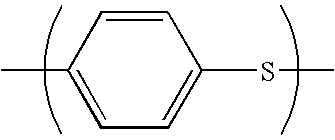Polyester resin composition
a technology of polymer resin and composition, applied in the field of polymer resin composition, can solve the problems of inability to obtain compositions with an impact strength of 500 j/m or more in a low temperature atmosphere, significantly decline in impact properties, and poor flexibility of polymer resin impact properties, etc., to achieve excellent flowability and chemical resistance, excellent flexibility and impact properties
- Summary
- Abstract
- Description
- Claims
- Application Information
AI Technical Summary
Benefits of technology
Problems solved by technology
Method used
Image
Examples
reference example 1
Method for Producing Polyphenylene Sulfide Resin (C-1)
[0117] A 20-liter autoclave with a stirrer and having a valve at the bottom was charged with 2383 g (20.0 moles) of 47% sodium hydrosulfide (produced by Sankyo Kasei Co., Ltd.), 831 g (19.9 moles) of 96% sodium hydroxide, 3960 g (40.0 moles) of N-methyl-2-pyrrolidone (hereinafter abbreviated as NMP), and 3000 g of ion exchange water. While nitrogen was kept fed at atmospheric pressure, the reaction vessel was gradually heated up to 225° C., taking about 3 hours, to distil away 4200 g of water and 80 g of NMP, and the reaction vessel was cooled to 160° C. The amount of water remaining in the system per mole of the supplied alkali metal sulfide was 0.17 mole. Furthermore, the amount of hydrogen sulfide scattered per mole of the supplied alkali metal sulfide was 0.021 mole.
[0118] Then, 2942 g (20.0 moles) of p-dichlorobenzene (produced by Sigma-Aldrich) and 1515 g (15.3 moles) of NMP were added, and the reaction vessel was sealed...
reference example 2
Method for Producing Polyphenylene Sulfide Resin (C-2)
[0122] A 20-liter autoclave with a stirrer was charged with 2383 g (20.0 moles) of 47% sodium hydrosulfide (produced by Sankyo Kasei Co., Ltd.), 848 g (20.4 moles) of 96% sodium hydroxide, 3267 g (33 moles) of NMP, 531 g (6.5 moles) of sodium acetate and 3000 g of ion exchange water. While nitrogen was kept fed at atmospheric pressure, the reaction vessel was gradually heated up to 225° C., taking about 3 hours, to distil away 4200 g of water and 80 g of NMP, and subsequently, the reaction vessel was cooled to 160° C. The scattered amount of hydrogen sulfide was 0.018 mole per mole of the supplied alkali metal sulfide.
[0123] Then, 3031 g (20.6 moles) of p-dichlorobenzene (produced by Sigma-Aldrich) and 2594 g (26.2 moles) of NMP were added, and the reaction vessel was sealed under nitrogen gas. With stirring at 400 rpm, the reaction vessel was heated up to 227° C. at a rate of 0.8° C. / min, subsequently heated up to 270° C. at ...
reference example 3
Method for Producing Liquid Crystal Resin (C-3)
[0125] A reaction vessel with stirring blades and a distillate pipe was charged with 901 parts by weight of p-hydroxybenzoic acid, 126 parts by weight of 4,4′-dihydroxybiphenyl, 112 parts by weight of terephthalic acid, 346 parts by weight of polyethylene terephthalate with an intrinsic viscosity of about 0.6 dl / g and 884 parts by weight of acetic anhydride. The reaction vessel was heated up to 150° C., taking 2 hours, heated from 150° C. to 250° C., taking 3 hours, heated from 250° C. to 300° C., taking 2 hours, made to react at 300° C. for 1.5 hours, reduced in pressure to 0.5 mm Hg at 300° C., taking 1.5 hours, and further made to react for 10 minutes for polymerization. As a result, a liquid crystal resin (C-3) composed of 72.5 molar equivalents of aromatic oxycarbonyl units, 7.5 molar equivalents of aromatic dioxy units, 20 molar equivalents of ethylene dioxy units, and 27.5 molar equivalents of aromatic dicarboxylic acid units a...
PUM
| Property | Measurement | Unit |
|---|---|---|
| particle size | aaaaa | aaaaa |
| particle size | aaaaa | aaaaa |
| melt viscosity | aaaaa | aaaaa |
Abstract
Description
Claims
Application Information
 Login to View More
Login to View More - R&D
- Intellectual Property
- Life Sciences
- Materials
- Tech Scout
- Unparalleled Data Quality
- Higher Quality Content
- 60% Fewer Hallucinations
Browse by: Latest US Patents, China's latest patents, Technical Efficacy Thesaurus, Application Domain, Technology Topic, Popular Technical Reports.
© 2025 PatSnap. All rights reserved.Legal|Privacy policy|Modern Slavery Act Transparency Statement|Sitemap|About US| Contact US: help@patsnap.com



